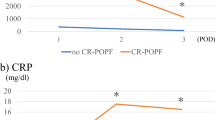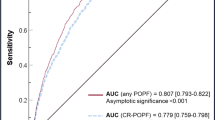Abstract
Background
Pancreaticoduodenectomy (PD) has recently been improved due to its increased safety. However, postoperative pancreatic fistula (POPF) remains a lethal complication of PD. Identifying novel clinicophysiological risk factors for POPF during the early post-PD period would help improve patient morbidity and mortality. Therefore, this retrospective study aimed to evaluate possible risk factors during the early postoperative period after pancreaticoduodenectomy (PD).
Methods
Data from 349 patients who underwent PD between 2007 and 2012 were examined retrospectively. All patients were classified into 2 groups: group A, patients without fistulae or biochemical leaks (288 patients), and group B, those with grade B or C POPF (61 patients). Data on various clinicophysiological parameters, including serum and drain laboratory data, were collected. Univariate and multivariate analyses were performed to evaluate POPF predictors. A predictive nomogram was established for these results.
Results
Univariate analysis showed that various serum and drain-related factors, such as white blood cell count, C-reactive protein levels, drain amylase (DAMY) levels, and drain lipase (DLIP) levels, were possible POPF risk factors. Multivariate analysis confirmed that postoperative day (POD) 1 DLIP levels (hazard ratio, 15.393; p = 0.037) and decreased rate (POD3/1) of DAMY levels (hazard ratio, 4.415; p = 0.028) were independent risk factors. Further, POD1 DLIP levels and decreased rate of DAMY levels were significantly lower in group A than in group B. The accuracy of nomogram was 0.810.
Conclusions
POD1 DLIP levels (> 245 U/mL) and decreased rate of DAMY levels (> 0.44) were POPF risk factors, making them possible biomarkers for POPF.

Similar content being viewed by others
References
Kimura W, Miyata H, Gotoh M et al (2014) a Pancreaticoduodenectomy risk model derived from 8575 cases from a national single-race population (Japanese) using a web-based data entry system: the 30-day and in-hospital mortality rates for pancreaticoduodenectomy. Ann Surg 259:773–780
Winter JM, Cameron JL, Campbell KA et al (2006) 1423 pancreaticoduodenectomies for pancreatic cancer: a single-institution experience. J Gastrointest Surg 10:1199–1210
Topal B, Fieuws S, Aerts R et al (2013) Pancreaticojejunostomy versus pancreaticogastrostomy reconstruction after pancreaticoduodenectomy for pancreatic or periampullary tumours: a multicentre randomised trial. Lancet Oncol 14:655–662
Iizawa Y, Kato H, Kishiwada M et al (2017) Long-term outcomes after pancreaticoduodenectomy using pair-watch suturing technique: different roles of pancreatic duct dilatation and remnant pancreatic volume for the development of pancreatic endocrine and exocrine dysfunction. Pancreatology 17:814–821
Inoue Y, Saiura A, Yoshioka R et al (2015) Pancreatoduodenectomy with systematic mesopancreas dissection using a supracolic anterior artery-first approach. Ann Surg 262:1092–1101
Senda Y, Shimizu Y, Natsume S et al (2018) Randomized clinical trial of duct-to-mucosa versus invagination pancreaticojejunostomy after pancreatoduodenectomy. Br J Surg 105:48–57
Newhook TE, LaPar DJ, Lindberg JM et al (2015) Morbidity and mortality of pancreaticoduodenectomy for benign and premalignant pancreatic neoplasms. J Gastrointest Surg 19:1072–1077
Maggino L, Malleo G, Bassi C et al (2019) Decoding grade B pancreatic fistula: a clinical and economical analysis and subclassification proposal. Ann Surg 269:1146–1153
Kawai M, Kondo S, Yamaue H et al (2011) Predictive risk factors for clinically relevant pancreatic fistula analyzed in 1,239 patients with pancreaticoduodenectomy: multicenter data collection as a project study of pancreatic surgery by the Japanese Society of Hepato-Biliary-Pancreatic Surgery. J Hepatobiliary Pancreat Sci 18:601–618
Aoki S, Miyata H, Konno H et al (2017) Risk factors of serious postoperative complications after pancreaticoduodenectomy and risk calculators for predicting postoperative complications: a nationwide study of 17,564 patients in Japan. J Hepatobiliary Pancreat Sci 24:243–251
Wada K, Traverso IW (2006) Pancreatic anastomotic leak after the whipple procedure is reduced using the surgical microscope. Surgery 139:735–742
Gaujoux S, Cortes A, Couvelard A et al (2010) Fatty pancreas and increased body mass index are risk factors of pancreatic fistula after pancreaticoduodenectomy. Surgery 148:15–23
Deng Y, Zhao B, Yang M et al (2018) Association between the incidence of pancreatic fistula after pancreaticoduodenectomy and the degree of pancreatic fibrosis. J Gastrointest Surg 22:438–443
Kawai M, Tani M, Terasawa H et al (2006) Early removal of prophylactic drains reduces the risk of intra-abdominal infections in patients with pancreatic head resection: prospective study for 104 consecutive patients. Ann Surg 244:1–7
Kajiwara T, Sakamoto Y, Morofuji N et al (2010) An Analysis of risk factors for pancreatic fistula after pancreaticoduodenectomy: clinical impact of bile juice infection on day 1. Langenbecks Arch Surg 395:707–712
de Reuver PR, Gundara J, Hugh TJ et al (2016) Intra-operative amylase in peri-pancreatic fluid independently predicts for pancreatic fistula post pancreaticoduodectomy. HPB (Oxford) 18:608–614
Bassi C, Marchegiani G, Dervenis C et al (2017) The 2016 update of the international study group (ISGPS) definition and grading of postoperative pancreatic fistula: 11 years after. Surgery 161:584–591
Büchler MW, Friess H, Wagner M et al (2000) Pancreatic fistula after pancreatic head resection. Br J Surg 87:883–889
Kim JH, Yoo BM, Kim JH et al (2009) Which method should we select for pancreatic anastomosis after pancreaticoduodenectomy? World J Surg 33:326–332
Pulvirenti A, Marchegiani G, Pea A et al (2018) Clinical implications of the 2016 international study group on pancreatic surgery definition and grading of postoperative pancreatic fistula on 775 consecutive pancreatic resections. Ann Surg 268:1069–1075
Frymerman AS, Schuld J, Ziehen P et al (2010) Impact of postoperative pancreatic fistula on surgical outcome-the need for a classification-driven risk management. J Gastrointest Surg 14:711–718
Fuks D, Piessen G, Huet E et al (2009) Life-threatening postoperative pancreatic fistula (grade c) after pancreaticoduodenectomy: incidence, prognosis, and risk factors. Am J Surg 197:702–709
Fong ZV, Correa-Gallego C, Ferrone CR et al (2015) Early drain removal—the middle ground between the drain versus no drain debate in patients undergoing pancreaticoduodenectomy. A Prospective Validation Study. Ann Surg 262:378–383
Molinari E, Bassi C, Salvia R et al (2007) Amylase value in drains after pancreatic resection as predictive factor of postoperative pancreatic fistula results of a prospective study in 137 patients. Ann Surg 246:281–287
Bertens KA, Crown A, Clanton J et al (2007) What is a better predictor of clinically relevant postoperative pancreatic fistula (CR-POPF) following pancreaticoduodenectomy (PD): postoperative day one drain amylase (POD1DA) or the fistula risk score (FRS)? HPB (Oxford) 19:75–81
Kosaka H, Satoi S, Yamamoto T et al (2019) Clinical impact of the sequentially-checked drain removal criteria on postoperative outcomes after pancreatectomy: a retrospective study. J Hepatobiliary Pancreat Sci 26:426–434
Yamashita S, Ishizawa T, Mori K et al (2017) Pancreatic chymotrypsin activity rather than amylase level better predicts postoperative pancreatic fistula. Ann Surg. https://doi.org/10.1097/SLA.0000000000002581
Thomson HJ, Obekpa PO, Smith AN et al (1987) Diagnosis of acute pancreatitis: a proposed sequence of biochemical investigations. Scand J Gastroenterol 22:719–724
Nordestgaard AG, Wilson SE, Williams RA (1988) Correlation of serum amylase levels with pancreatic pathology and pancreatitis etiology. Pancreas 3:159–161
Apple F, Benson P, Preese L et al (1991) Lipase and pancreatic amylase activities in tissues and in patients with hyperamylasemia. Am J Clin Pathol 96:610–614
Smith RC, Southwell-Keely J, Chesher D (2005) Should serum pancreatic lipase replace serum amylase as a biomarker of acute pancreatitis? ANZ J Surg 75:399–404
Yadav D, Agarwal N, Pitchumoni CS (2002) A critical evaluation of laboratory tests in acute pancreatitis. Am J Gastroenterol 97:1309–1318
Gagnière J, Abjean A, Franz M et al (2017) A normal preoperative lipase serum level is an easy and objective risk factor of pancreatic fistula after pancreaticoduodenectomy. Pancreas 46:1133–1140
Facy O, Chalumeau C, Poussier M et al (2012) Diagnosis of postoperative pancreatic fistula. Br J Surg 99:1072–1075
Kim JY, Park JS, Kim JK et al (2013) A model for predicting pancreatic leakage after pancreaticoduodenectomy based on the international study group of pancreatic surgery classification. Korean J Hepatobiliary Pancreat Surg 17:166–170
Huang XT, Huang CS, Liu C et al (2020) Development and validation of a new nomogram for predicting clinically relevant postoperative pancreatic fistula after pancreatoduodenectomy. World J Surg. https://doi.org/10.1007/s00268-020-05773-y
Acknowledgements
No financial support was received for this study. The authors declare no conflicts of interest associated with this study.
Funding
No financial support was received for this study.
Author information
Authors and Affiliations
Corresponding author
Ethics declarations
Conflict of interest
None declared.
Informed consent
The requirement for obtaining written informed consent from each patient was waived because of the retrospective study design.
Human or animal rights
This study was approved by the Research Ethics Committee of Tokyo Women’s Medical University (acceptance number: 4605). All procedures were performed in accordance with the ethical standards of the Institutional Research Committee and the 1964 Helsinki Declaration.
Additional information
Publisher's Note
Springer Nature remains neutral with regard to jurisdictional claims in published maps and institutional affiliations.
Rights and permissions
About this article
Cite this article
Suzuki, S., Shimoda, M., Shimazaki, J. et al. Drain Lipase Levels and Decreased Rate of Drain Amylase Levels as Independent Predictors of Pancreatic Fistula with Nomogram After Pancreaticoduodenectomy. World J Surg 45, 1921–1928 (2021). https://doi.org/10.1007/s00268-021-06038-y
Accepted:
Published:
Issue Date:
DOI: https://doi.org/10.1007/s00268-021-06038-y




